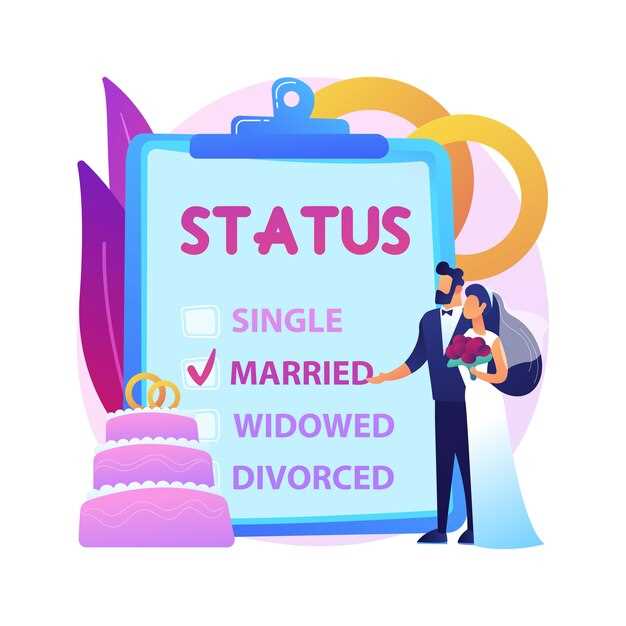Couples who reach engagement after about two to four years typically have had time to test compatibility across finances, conflict patterns and family dynamics; this period allows partners to evaluate whether core القيم align and whether both parties are prepared for shared legal and financial commitments (источник: multiple longitudinal surveys). Quick engagements can succeed, but compressing major decisions earlier raises the likelihood that unresolved issues will persist after vows.
Practical milestones to keep track of by year: at 6–12 months confirm exclusivity and initial conflict-management style; by 12–24 months have frank discussions about money, children, religion and career plans; by 24–36 months integrate social networks and observe how extended family interactions affect daily life; by 36–60 years – pardon, years – evaluate long-term planning readiness and finalize agreements such as prenups or shared accounts. Make sure each milestone has measurable outcomes reached, not just intentions.
Specific actions that contribute to stronger outcomes: complete a finances checklist, attend at least three premarital counseling sessions, set a joint budget trial for six months, and document non-negotiable expectations. Among factors that predict greater stability are aligned life goals, effective communication habits and previous experience handling crises together; perception of readiness often changes after cohabitation or a major shared expense.
Keep partners accountable to agreed checkpoints: set target dates for conversations, calendar follow-ups and an agreed decision window for engagement. Be mindful that rose-colored early attraction is not a substitute for evidence of partnership resilience; being engaged should follow demonstrated ability to solve problems together, not a deadline.
Set a Dating Timeline Around Personal Milestones
Make engagement contingent on meeting specific, measurable milestones: financial stability (6–12 months of emergency savings plus 12–24 months of stable income), a career checkpoint (finished degree or 12–24 months at a job that supports shared living), and a relational foundation (resolved core disagreements about children, money, religion and housing with mutual plans documented).
Read recent analysis from the Pew Research Center – which writes about rising ages at first marriage in America – to ground decisions in demographic context: Pew Research Center. Wilcox also writes that marrying older often correlates with greater stability and lower likelihood of becoming divorced, while Emory research points to changing perception of what makes a marriage durable. These findings seem to confirm what discerning couples report: timing matters where finances and maturity intersect.
Checklist to keep on hand: a) mutual budget and 6–12 month emergency fund; b) shared answers to three child-related scenarios; c) clear expectations for living arrangements and elder-care roles; d) documented division of major expenses; e) at least one extended-family holiday tested together. Communicate these items early and re-check them after major job changes or relocations.
Example plan fueled by milestones: dated seriously for 12–24 months, then test cohabitation for 6–12 months while keeping separate emergency buffers; if both partners still agree on the same goals and provide mutual emotional and financial support, consider becoming engaged. Some would move faster after clear alignment; others wait longer for career or educational reasons. This approach keeps focus on measurable progress rather than arbitrary clocks.
Practical points to think about: keep discussions factual (salaries, savings, liabilities), role-play conflict scenarios, agree on a post-engagement checklist (legal, beneficiary, joint accounts) and set a sensible engagement period tied to completing any outstanding milestones. Acknowledges common myths that a long engagement alone ensures success; stability is built by work on foundation issues, not by time elapsed.
Map career and education goals to a realistic engagement window
Plan a minimum engagement window of 12–24 months after major education or career milestones; for residency, fellowship or multi-year PhD work extend planning to 24–36 months based on the specific situation and financial baseline.
Practical maps by scenario: young partners still in undergraduate programs should wait until degree completion plus at least 12 months to stabilize housing, income and social networks; graduate students aiming for thesis or comprehensive exams should delay engagement until after defense or qualifying exams plus 6–12 months; medical trainees and others with multi-year training commonly benefit from 24–36 months post-training or from the final, less intense year of training. Older partners with established careers often compress the window to 6–12 months, provided both partners keep clear timelines and shared responsibilities documented.
Consider career transitions like major promotions or relocations as separate milestones: allow 6–12 months after a new role, and 12 months after an interstate or international move to observe schedule alignment and local support. If someone has significant student debt or unpredictable seasonal work, add another 6–12 months to build a contingency fund; researchers link financial stability and completed education with lower rates of separation.
Address social and relationship mechanics within the window: read outcome studies and internalize that myths about quick engagement proving strong love are common; the same research acknowledges that readiness – emotional, logistical and financial – forms the foundation of durable marital outcomes. Use dated decision points (job offer accepted, degree conferred, lease signed) as objective markers in the process rather than vague intentions.
Small checklist to keep the engagement window realistic: joint budget covering 3–6 months of expenses, agreed parenting preferences if relevant, shared expectations for household roles, one little trial period of cohabitation or intensified joint planning, and at least one major stress-test (move, work deadline) handled together before wedding planning speeds up.
Conclusion: youre most likely to enter a strong marital phase when engagement timing aligns with completed education or stabilized career roles, measured in months and concrete milestones rather than vague promises.
Choose a cohabitation period to evaluate day-to-day compatibility
Set a 6–12 month cohabitation trial: 6 months minimum to surface daily friction and 12 months to observe seasonal routines; extend to 18–24 months when joint children, mortgage or major relocation are planned.
Use a written checklist called a “living audit” that partners fill weekly. Include: percentage split of household chores (target: within 10% variance), bill contribution method (50/50 or income-proportional, logged each month), frequency of unresolved arguments (red flag: more than 2 per month), sleep and work-schedule clashes (documented for 30 days), guest and family boundaries, shared grocery/menu preferences, and handling of minor emergencies. An important metric is time-to-repair: how long until a disagreement is discussed and a solution reached; aim for discussion within 72 hours and closure within two weeks. Track these items in a simple shared spreadsheet; provided youve logged data for three months, trends become visible.
Use decision rules tied to the audit: if alignment on core values and aspirations covers >=80% of items (finances, children, religion, career moves) and the couple’s conflict frequency drops by >50% during the trial, prospects for longevity are higher and a move toward formal commitment is reasonable. Madeleine writes in источник and acknowledges that many couples call this phase a reality check; those who reach stable routines and mutual problem-resolution would more often report confidence that the person they live with can become a long-term partner. If metrics are less aligned, negotiate targeted changes and re-test for another 3–6 months rather than making a final choice immediately–this gives little time for adjustment but avoids premature decisions that might later cause regret or wonder.
Set concrete financial targets (savings, debt reduction) before proposing
Establish these numeric targets immediately: emergency fund = 6× fixed monthly expenses; unsecured consumer debt ≤10% of combined gross income; credit-card utilization <10% (absolute cap 30%); debt-to-income ratio ≤36%; allocate 15–20% of gross pay toward joint goals (10% retirement, 5% down‑payment/wedding/ring). Dont rely on one-off gifts to close gaps.
| الهدف | Metric | Target | Typical timeline |
|---|---|---|---|
| Emergency fund | Months of fixed expenses | 6× | Amount ÷ monthly savings (example below) |
| Unsecured debt | Debt ÷ combined gross income | ≤10% | 6–24 months depending on interest and consolidation |
| Credit utilization | Revolving balances ÷ limits | <10% (max 30%) | 1–6 months |
| DTI (all debt) | Monthly debt payments ÷ gross income | ≤36% | 6–36 months |
| Joint savings rate | % of gross | 15–20% | ongoing; adjust every 6 months |
Actionable steps: automate transfers on the 25th of each month to separate accounts called “emergency,” “house/down,” and “wedding/ring”; consolidate cards with rates >18% into a 10–12% personal loan; negotiate or refinance student loans if rate differential >3 percentage points; each person lists their top three debts so both acknowledge priorities.
Concrete example: combined gross $6,000/month, fixed expenses $3,000 → emergency fund = $18,000. At a 15% combined savings rate ($900/month) time = 20 months; increase savings to 20% ($1,200/month) → 15 months. These arithmetic points remove perception-based delays and counter common myths that love alone covers financial gaps.
Among couples, earlier clarity on these figures shortens engagement length and reduces conflict; another useful checkpoint is a 6‑month review tied to the first or planning anniversary. According to common finance benchmarks, meeting these targets creates a foundation for more stable relationships and fewer surprises for families and future life plans.
Conclusion: set numeric targets, automate on fixed dates (25th recommended), monitor quarterly, wait to propose until benchmarks met or a clear plan exists; this approach always shifts perception from emotion-only decisions to measurable readiness and gives both persons concrete points for conversation.
Plan timing for core value conversations: children, religion, long-term goals
Start core-value talks about children, religion and long-term goals by month 6–12; address absolute dealbreakers within months 0–3 and revisit alignment before any engagement or formal wedding planning.
- 0–3 months (triage): cover dealbreakers that end relationships quickly – refusal to have children, fundamental religious incompatibility, or plans to relocate internationally. Reason: these facts reduce wasted time if attractions are strong but values clash.
- 3–12 months (core): schedule focused conversations about desired number of children, frequency of religious practice, and five‑year aspirations. Research and multiple studies report the average couple has clear positions by month 6–12; aim to have positions read and recorded mentally by month 12.
- 12–24 months (confirmation): test real‑world compatibility: finances with children, rituals at holidays, career moves tied to university or employer decisions, and wedding expectations. Use this window to confirm readiness for engagement or shared living.
Concrete markers of progress:
- Count agreements: if partners agree on at least 3 of 4 core items (children, religion, relocation, career sacrifices) the relationship is more likely to be fueled by compatible aspirations than by attractions only.
- Time spent discussing: allocate 60–90 minutes per topic across 2–4 conversations; shorter chats lead to less clarity.
- Behavioral test: attend a religious service together, discuss childcare logistics during a weekend, or simulate joint budgeting for a child – actions reveal true dynamics faster than hypothetical talk.
Practical agenda for each conversation (sensible format):
- State personal view in one sentence (example: “I want two children and to raise them in my religion”).
- Ask for partner’s concise reply; note agreements and non‑negotiables.
- List adjustments each is prepared to make and timeline for those adjustments.
- Set a review date within 3–6 months to reassess alignment based on real choices and events.
Indicators a couple is ready to formalize commitment:
- Shared plan for children (timing, childcare, finances) documented within household budgeting.
- Mutual view on religious practice frequency and role in child upbringing.
- Aligned five‑year aspirations with explicit compromises outlined.
Evidence from social research: university researchers and longitudinal study teams find that mismatch on core values predicts separation more strongly than mismatch on attractions or leisure preferences. For example, couples who spent less than a year hashing out parenting plans were more likely to split post‑childbirth in several studies.
Short scripts and examples:
- Script: “My ideal family size is two; I’m ready to relocate if partner’s career requires it. What’s your view?”
- Example – madeleine: madeleine and her partner allocated three conversations over two months; they discovered alignment on religion but different plans for children; they negotiated a compromise and set a review in 18 months.
Do and dont checklist:
- Do document positions and timelines provided in conversation notes.
- Do use third‑party research to inform realistic expectations (look up studies on relationship dynamics and parenting outcomes).
- Dont ignore small disagreements; less friction early often signals avoidance rather than true alignment.
Final rule of thumb: honesty about dealbreakers within the first three months, full value alignment by month 12, and behavioral confirmation by month 24 produces the most sensible outcomes in long‑term relationships; this reduces later regrets and aligns wedding and family choices with shared aspirations and love.
Adjust Your Timeline When Marrying Later in Life
Recommendation: Reserve 12–24 months of focused vetting and integration with a partner before marrying later in life, including a minimum 6–9 months of shared living or extended visits and a 3–6 month cycle for joint financial planning and legal preparation.
Numerous peer analyses of americans indicated that first marriage success peaks for unions formed in the late 20s to early 30s; among later unions, good outcomes are achievable but require targeted work because divorce rates shift with prior marriages, health status, and financial entanglements. Read cohort studies showing that age alone is not fatal to success–context and alignment drive outcome variance more than chronological age.
Consider a measurable checklist with deadlines: within 3 months, exchange full financial disclosures and draft a prenup if assets or prior marriages exist; within 6 months, complete joint budget simulations, tax-filing scenarios, and retirement projections; within 6–9 months, test shared living rhythms, household role division, and caregiving logistics for existing children; within 12 months, finalize estate documents and beneficiary designations. Each item should have a decision point (green/amber/red) and a planner or counselor assigned if amber.
Perception gaps are the leading drift driver: conduct explicit conversations on core values, religion, parenting, career transitions, and health care preferences rather than assuming alignment. Build routine check-ins (monthly for the first year) that track progress on the checklist and flag unresolved items; never postpone discussions about debt, long-term care, or blended-family boundaries–delays often become fatal stressors. Also assess social network overlap and shared friend support, because social reinforcement drives resilience for a couple doing life together.
If youve been previously married, add two adjustments: extend the planning window by 6 months to address legacy obligations and require mediation on parenting time schedules; and require both partners to meet with a financial planner and therapist before setting a wedding date. This protocol increases the probability of measurable success and aligns expectations for the marriage you really want.
How age and past relationships should influence dating length
Recommendation: aim for 12–18 months of exclusive partnership when both partners have moderate prior relationships; extend to 18–24 months with little prior exposure, and consider 6–12 months for older partners with strong histories of long relationships, provided key checkpoints are met.
- Under 25: target 18–24 months. Multiple studies and researchers find that emotional maturity and conflict-resolution skills often develop across this span; marriages reached within under 12 months show a higher percentage of early instability (roughly 20–30% greater risk of separation in several cohort studies).
- 25–34: target 12–18 months. If each partner has several prior relationships and demonstrated pattern learning, a shorter window (9–12 months) might be sensible, but make sure core compatibility points are established.
- 35 and older: target 6–12 months when partners have strong, stable relationship histories; researchers find prior long-term relationships contribute to faster recognition of deal-breakers and increase marital stability within the first five years.
Checklist of decision points to evaluate progress before marrying:
- Communication: both partners can discuss conflict patterns, finances, and expectations without escalation–if doing so still triggers unresolved cycles, stay longer.
- Values alignment: children, religion, career goals–agreement on at least 75% of major points is a sensible threshold before becoming co-parents or spouses.
- Behavioral evidence: time-tested reactions under stress; each stressful episode should demonstrate repair attempts and growth rather than repeated harmful patterns.
- Social integration: families and close friends see a strong support pattern and report increased confidence in the couple’s longevity.
- Financial transparency: joint planning and honest sharing of debts/assets reached within the timeline indicate readiness for shared legal commitments.
Practical rule of thumb based on research synthesis: if 6 of 8 core checkpoints are reached within the recommended window for your age/experience bracket, marrying may be sensible; if fewer than 4 are met, extend the period. Researchers find that reaching checkpoints earlier does not always equal longevity unless behavior change is sustained over time.
- When prior trauma or little prior relationship experience exists, add an extra 6–12 months focused on therapy or structured relationship work; this contributes directly to marital stability.
- For couples compressing timelines (shorter windows), document evidence of sustained compatibility across contexts and consider a formal premarital assessment; studies show couples who complete structured prep work have higher stability percentages within the first five years.
- Always track objective markers rather than feelings alone: number of unresolved conflicts, financial transparency score, agreement on parenting, and observed repair attempts–use these points to decide whether to stay in the current timeline or extend it.
Balancing fertility planning with relationship pacing
Recommendation: If the female partner is 35 or older, begin timed conception attempts within 6 months of deciding to plan a family; if both partners are under 30, a 12–24 months shared window before trying is reasonable while monitoring ovarian markers.
Data points: peak natural per-cycle conception rates are roughly 20-25% in the early-to-mid 20s, decline to about ~15% by 35 and to ~5% by 40 (classic wilcox estimates and later cohort studies). Miscarriage rates rise from ~10–15% under 35 to ~20–35% at 35–39 and higher after 40. In America the median ages for first childbearing and marriage rose over recent decades, so americans and couples must reconcile longevity of partnership goals with a biologic window that is finite.
Triage rules for planning: if female <35, try for a minimum of 12 months of unprotected sex before fertility referral; if 35–39, evaluate after 6 months; if ≥40, consult a fertility specialist and run AMH, antral follicle count and semen analysis immediately. For couples where one partner has known risk factors (endometriosis, chemo exposure, prior surgery), shorten timelines and refer sooner. Example: a 37‑year‑old woman who delays attempting conception 18 months will often face markedly lower monthly conception probability and a higher chance of needing ART; treating fertility as something to fix later can be nearly fatal to those plans.
Practical steps couples can take while pacing relationship milestones: create a shared fertility checklist, schedule baseline tests within 3 months of serious planning, set clear months-based checkpoints (3, 6, 12), and agree on a minimum fertility evaluation trigger. If youve discussed family size and timelines during engagements or early cohabitation, update plans every 6 months. The answer is never purely chronological; it acknowledges reproductive age, health, and each couple’s unique priorities.


 How Long Should You Date Before Marriage? Timeline & Tips">
How Long Should You Date Before Marriage? Timeline & Tips">



 How Not to Worry About What Others Think of You — 10 Practical Tips">
How Not to Worry About What Others Think of You — 10 Practical Tips">
 How Childhood Made It Hard to Trust Men — Learning Vulnerability">
How Childhood Made It Hard to Trust Men — Learning Vulnerability">
 Red Flags in Relationships – What to Look For & How to Respond">
Red Flags in Relationships – What to Look For & How to Respond">
 Why You Keep Dating Jerks — Causes, Patterns & How to Break the Cycle">
Why You Keep Dating Jerks — Causes, Patterns & How to Break the Cycle">
 Having a Baby in Your Late 30s or 40s – Expert Advice I Give My Patients">
Having a Baby in Your Late 30s or 40s – Expert Advice I Give My Patients">
 How to Overcome Dating App Fatigue – 10 Practical Tips">
How to Overcome Dating App Fatigue – 10 Practical Tips">
 Get Him Back – 9 Proven Tips to Get a Second Chance With a Guy">
Get Him Back – 9 Proven Tips to Get a Second Chance With a Guy">
 Man Gone Cold & Distant? How to Make Him Attracted Again">
Man Gone Cold & Distant? How to Make Him Attracted Again">
 7 Unrealistic Dating Standards Guys Need to Let Go">
7 Unrealistic Dating Standards Guys Need to Let Go">
 Why Can’t I Get Over My Crush? Causes & How to Move On">
Why Can’t I Get Over My Crush? Causes & How to Move On">